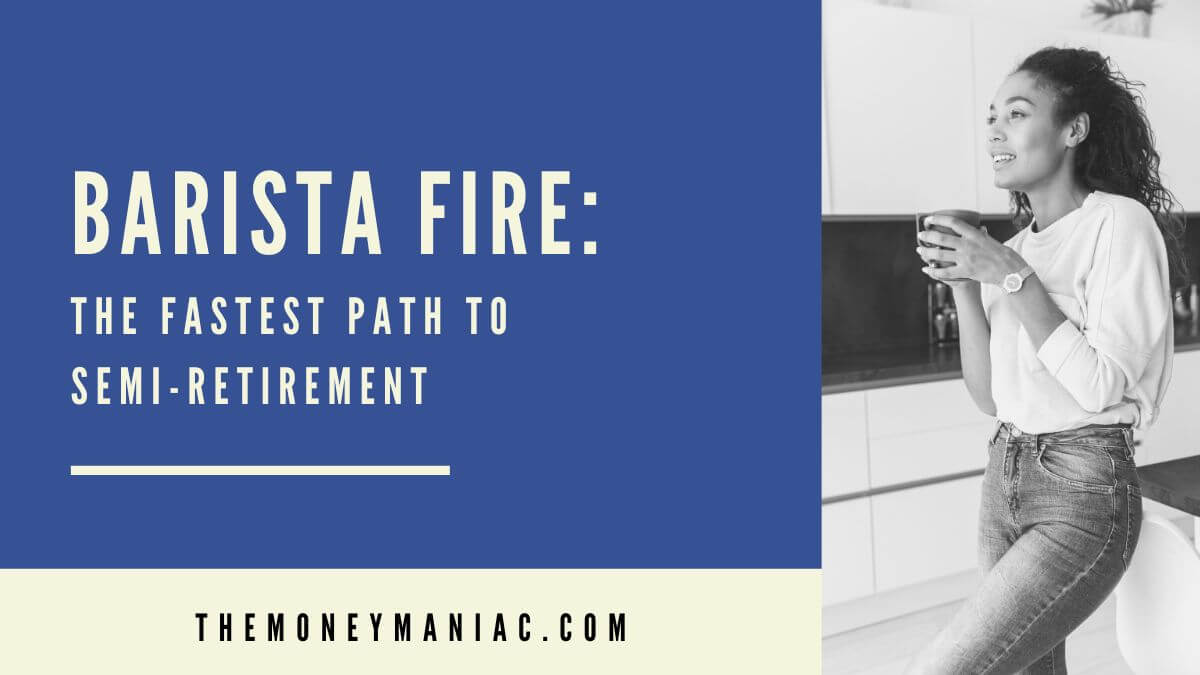With an average retirement age of 65, few Americans even consider retiring before 50. However, Barista FIRE can change all that.
Compared to other FIRE methods that may be out of reach for the average worker, Barista FIRE is perfect for those who want to retire early (even if they can’t build a big investment portfolio).
Rather than waiting to amass $1 to $2 million, Barista FIRE offers a way to enjoy financial independence without having to live frugally.
So if you’re looking for a FIRE plan that’s easy to achieve, it’s time to explore the wonderful world of Barista FIRE. This article will cover how much money Barista FIRE takes, its pros and cons, and the best Barista FIRE jobs (that don’t involve coffee).
What Is Barista FIRE?
Barista FIRE is all about using a part-time job to supplement your income and provide health insurance. This way, you can achieve financial independence decades earlier than other options.
For many people, saving 25 times their annual expenses for full FIRE can seem nearly impossible.
However, with Barista FIRE, you don’t need to save nearly that much. In fact, you may only need 10 to 20 times your annual expenses.
Plus, with the benefit of employer-sponsored health insurance, Barista FIRE makes it much easier to downshift to partial retirement and start enjoying a more balanced life today.
How Does Barista FIRE Work?
If the thought of working part-time during retirement appeals to you, Barista FIRE could be your quickest path to financial independence. Let’s review what it takes to put this plan into action.
Determine Your Barista FIRE Number
The key to Barista FIRE is calculating your Barista FIRE number. This is the amount of money you need in your portfolio so that you can ditch the 9-to-5 grind for semi-retirement. It depends heavily on your lifestyle and how much you plan on working in retirement.
Here is the four-step process to calculate your Barista FIRE number:
Step 1: First, determine your expenses during retirement. Take a moment and think about how your life will look. Do you want to travel more? Are you planning on downsizing? Do you want to enjoy the finer things in life? A good rule of thumb is to take your current budget and add some cushion or “fun” money for enjoying your newfound freedom.
Step 2: Next, decide how much you plan to work. For example, let’s say you plan on getting a part-time job making $25 an hour for 20 hours per week. That would translate into $25,000 per year in pre-tax income.
Note: Don’t forget taxes. Depending on your location and filing status, this may reduce your take-home pay by 10% to 20%.
Step 3: Now, subtract your best estimate of your after-tax income from your living expenses. This is your annual shortfall or the amount of money you have to withdraw from your investments each year.
Step 4: Finally, multiply this annual shortfall by 25. This will give you your Barista FIRE number.
Note: This calculation takes into account the 4% rule, which is a handy trick for retirement planning. Based on historical data, this guideline states that you can safely cash out 4% of your investments each year (for 30 years) without risking running out of money.
Your traditional FIRE number indicates when you can fully retire, but your Barista FIRE number indicates when you can semi-retire.
If you downshift to part-time work anywhere between these two numbers, you can bridge the gap between your income and your desired expenses by withdrawing from your investments.
But the longer you can hold off on doing this, and the closer you can get to your FIRE number before going part-time, the more flexibility and safety you will have built into your plan.
Barista FIRE Example
Now, let’s put pen to paper and calculate your Barista FIRE number using a real-world example.
My friend Chris has been putting in grueling hours as a software developer for the past ten years, and he is at the point of burnout. Stress has taken a toll on his family life and is starting to affect his health.
Fortunately, he’s been able to save a fair amount for retirement. But he’s still over a decade away from full FIRE.
Can he downshift sooner using Barista FIRE?
After reviewing his budget and building in some extra “fun” money, he figures he will need $50,000 to cover his annual living expenses. And he anticipates covering half of that amount with a low-stress part-time job that will pay him $25,000 in after-tax income per year.
So if we subtract $25,000 in income from $50,000 in expenses, we see that his annual shortfall is $25,000. Multiplying the $25,000 shortfall by 25 gives us $625,000.
Rather than needing $1.25 million for traditional FIRE, Chris only needs half that amount to enjoy the benefits of Barista FIRE.
But $625,000 is still a substantial sum of money. What if he can’t Barista FIRE today?
That’s not a problem — he just needs a plan to get there.
Here’s how to approach Barista FIRE:
First, review your portfolio and make sure that you aren’t being overly conservative. For example, by switching away from a savings account or a bond-heavy investment strategy, you could significantly juice your returns.
The S&P 500 has returned more than 10% per year over the past 50 years. So by investing in equity index funds, you can plan on roughly doubling your portfolio every seven years according to the Rule of 72.
Note: The rule of 72 shows you how long it takes for an investment to double. Simply divide 72 by the anticipated return. In this example, 72 divided by 10 equals 7.2 years.
You can also consider getting a higher-paying job to supplement more of your living expenses during retirement, reducing your Barista FIRE number. For example, if Chris’ part-time job paid $30,000 per year, he would only need $500,000 (instead of $625,000) for Barista FIRE.
Or, you can just continue at your present job and cut back on expenses until you reach your Barista FIRE number.
The bottom line is that since you don’t need as much invested compared to other retirement options, Barista FIRE opens up more possibilities sooner.
And one of those possibilities is keeping Barista FIRE in your back pocket and not quitting your job at all. You can always continue working toward full FIRE, knowing that you have the option to leave at any time if it gets to be too stressful or unpleasant.
Pros and Cons of Barista FIRE
Like all retirement plans, Barista FIRE may not be suitable for everyone. But here are the primary benefits and drawbacks to consider.
Pros
Engagement. Studies show that staying engaged reduces dementia and Alzheimer’s risk and slows cognitive decline as we age. Keeping active with a part-time job can reduce these risks, alleviate boredom, and increase community interaction.
Downshift sooner. By requiring a smaller investment portfolio, Barista FIRE is easier to achieve. And this is meaningful because over 65% of workers claim that workplace stress has caused difficulties in their daily lives. With Barista FIRE, you will have the means to escape the rat race and pursue a job with less stress and/or more meaning.
Health insurance. Rising healthcare costs are a major concern for early retirees. By taking a part-time job with health benefits, you don’t have to worry about an unexpected emergency depleting your retirement savings.
More free time. A part-time job means more ‘me’ time. Use it to explore new hobbies, build personal relationships, or create passive income.
Preserve your portfolio during down markets. Consider working more hours or picking up another part-time job to safeguard your investments during market corrections. This helps you to avoid selling assets at a market bottom. Then when the market picks back up, you can return to your regular withdrawal schedule.
Do what you love. Have you always wanted to start a nonprofit or work in the great outdoors? You can start pursuing these passions earlier, rather than waiting until traditional retirement.
Cons
You still have to work. Since you will be working part-time, Barista FIRE may not feel like retirement. So if you want to avoid the workplace entirely, this solution likely isn’t for you.
Miss peak earning years. A 2023 U.S. Bureau of Labor Statistics report shows that peak earning years are between the ages of 35 and 54. By transitioning to part-time work in your 30s or 40s, you may miss out on substantial upside.
Career stalls. If you leave a promising position, you could jeopardize your career prospects. And if you decide to return to the workforce after several years, there’s no guarantee that your employer — or others in the industry — will take you back. Plus, returning full-time after a prolonged period of part-time work can be mentally and physically challenging.
Lifestyle creep. Since it may prove difficult to jump back into a high-paying job after several years away from the workforce, you will have to stay on top of your expenses. No matter how tempting that new car may be, you will need to resist lifestyle inflation, or you could risk running out of money later in life.
Interferes with travel. If you want to retire and travel the world, working part-time may put a damper on your plans. In this case, Barista FIRE may not be your best option.
You can’t fully unplug. Since work will be a part of your retirement, you may find it difficult to completely unplug. Also, with more demands being placed on workers today, you will need to create boundaries so your job doesn’t consume your free time.
Is Barista FIRE Right For You?
Barista FIRE is an excellent alternative to other FIRE methods. It gives you the freedom to enjoy life without being completely reliant on your investments. This way, you can enjoy financial independence while still working (albeit part-time) at a job you love.
Ideally, you will build a portfolio that supports lean FIRE and then use Barista FIRE to cover the extras that enhance your lifestyle. For example, if you want to take an extended or more expensive vacation, your active income will make that possible.
Barista FIRE is perfect for someone who wants to be financially independent but not fully retired.
However, before deciding on Barista FIRE, do some soul-searching to understand why you want to quit your current job. If it is affecting your health and relationships, Barista FIRE may be the perfect solution.
However, it’s probably not the best option if you just don’t like working. Barista FIRE won’t solve that problem. In fact, you may end up with the same amount of stress and even less income.
Related reading: Coast FIRE: The Fastest Way To Enjoy Stress-Free Living
Key Considerations For Barista FIRE
Before you take the plunge, here are 4 realities to keep in mind:
Your plans may change. No matter how well you anticipate your lifestyle and spending habits, know that things can always change. What if you decide to start a family or need to take care of your aging parents? After a few years away from your career, you may find it difficult to reenter the workforce to make additional income.
Increasing life expectancy. According to a recent Forbes article, Americans are living longer than ever due to advancements in medicine and technology. And you may not want to work a part-time job in your 70s and 80s. So be realistic and err on the side of caution when calculating your expenses and how long your plan to work.
Don’t let health issues ruin your retirement. In Barista FIRE, you need your part-time income to cover a portion of your expenses. So if you are unable to work due to an extended illness or disability, you could end up serious in trouble. Fortunately, a long-term disability insurance policy can protect you. This type of insurance will replace your W-2 income in the event that you can’t work, which will help you stay on track. A good rule of thumb is to expect to pay between 1% and 3% of your annual salary for coverage.
Inflation and volatility risks. Most traditional retirement models were built using a twenty-year horizon. However, with Barista FIRE, you could be looking at fifty years of semi-retirement. If you don’t adequately plan for inflation and volatility in your investments, you may risk depleting all of your assets. To avoid this fate, consider working an extra year or two to pad your retirement savings with some extra cushion.
Test The Waters
Barista FIRE can be a significant change.
So don’t dive in headfirst and hope for the best. After taking the plunge, you may decide that the lifestyle isn’t for you, or you might miss the excitement of your former job.
Instead, consider a trial run.
By taking an extended leave of absence or sabbatical, you can test the waters and see if Barista FIRE is the right choice for you (before risking your career).
Best Barista FIRE Jobs
Unlike its name, Barista FIRE rarely involves working at a coffee shop. Instead, use it to explore a job that you love without worrying about the pay.
And if that’s making coffee, more power to you.
But besides being a barista, here are a few jobs that lend themselves perfectly to the Barista lifestyle:
- Teach online (English as a second language is a popular choice)
- Seasonal jobs (part-time doesn’t mean you have to work all the time)
- Freelance work
- Gig jobs
- Consulting
However, if you like your current job and your employer offers health insurance, converting to a part-time position may be the right choice.
If not, the following companies offer health benefits for part-time workers:
- Starbucks
- Whole Foods
- United States Parcel (UPS)
- Costco
- Lowe’s
- Staples
Related reading: 13 Best FIRE Blogs For Financial Education And Inspiration
Final Thoughts
So, is Barista FIRE right for you?
If the thought of working (even part-time) fills you with dread, it might not be. In that case, you should probably consider Lean FIRE instead.
However, if you would prefer a longer semi-retirement to a shorter full-retirement, Barista FIRE is your best bet. It will enable you to enjoy the freedom of partial retirement years earlier than any other option.
And it may not make you a millionaire, but it will let you live life on your own terms.
After all, isn’t that what financial independence is all about?



